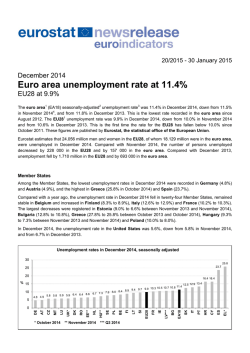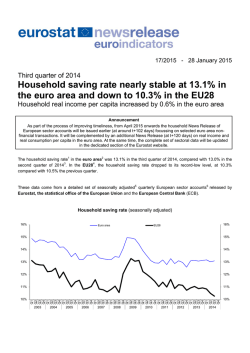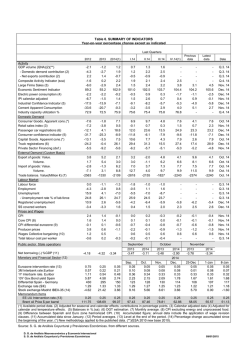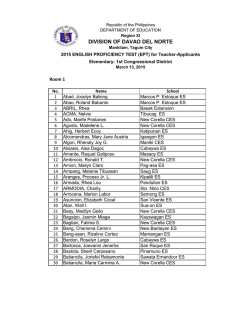
Read complete story - Division of Employment Security
North Carolina Department of Commerce - Labor and Economic Analysis Division News Release For More Information, Contact: Larry Parker/919.707.1010 For Immediate Release January 27, 2015 North Carolina’s December Employment Figures Released RALEIGH — The state’s seasonally adjusted December unemployment rate was 5.5 percent, decreasing 0.4 of a percentage point from November’s revised rate of 5.9 percent. After the monthly revision, November’s preliminary rate of 5.8 percent increased to 5.9 percent. The national rate is at 5.6 percent. North Carolina’s December 2014 unemployment rate was 1.4 percentage points lower than a year ago. The number of people employed increased 1,283 over the month to 4,364,022, and increased 25,339 over the year. The number of people unemployed decreased 15,843 over the month to 255,510, and declined 67,584 over the year. Seasonally adjusted Total Nonfarm industry employment, as gathered through the monthly establishment survey, increased 15,100 to 4,218,700 in December. Leisure & Hospitality Services, Professional & Business Services, and Trade, Transportation & Utilities are three major industries that had an over-the-month increase of 3,600, followed by Construction, 4,100; Financial Activities, 1,200; Information, 200; and Mining & Logging, 100. Major industries experiencing decreases were Government, 900; Education & Health Services, 200; Manufacturing, and Other Services both decreased by 100 jobs. Seasonally Adjusted Unemployment Rates Since December 2013 Dec. 2013 Jan. 2014 Feb. 2014 Mar. 2014 Apr. 2014 May 2014 June 2014 July 2014 Aug. 2014 Sept. 2014 Oct. 2014 Nov. 2014 Dec. 2014 N.C. 6.9 6.7 6.4 6.3 6.2 6.4 6.4 6.5 6.8 6.7 6.3 5.9 5.5 U.S. 6.7 6.6 6.7 6.7 6.3 6.3 6.1 6.2 6.1 5.9 5.8 5.8 5.6 *2013 Numbers Have Been Annually Revised* Since December 2013, Total Nonfarm jobs gained 114,500 with the Total Private sector growing by 119,900 and Government decreasing by 5,400. The largest over-the-year increase of major industries was Professional & Business Services at 40,200, followed by Trade, Transportation & Utilities, 17,600; Construction, 12,500; Leisure & Hospitality Services, 11,800; Education & Health Services, 10,400; Manufacturing, 9,500; Financial Activities, 8,100; Other Services, 4,700; Information, 5,000; and Mining & Logging, 100. The only major industry experiencing a decrease over the year was Government, 5,400. The next unemployment update is scheduled for Wednesday, February 4, 2015 when the county unemployment rates for December 2014 will be released. — More — This information may be accessed on the DES World Wide Web page, at http://www.ncesc.com North Carolina data is embargoed until 10:00 A.M., Tuesday, January 27, 2015 November 2014 December 2014 Numeric Change December 2013 Month Ago Percent Change Numeric Change Year Ago Percent Change North Carolina (Local Area Unemployment Statistics) Smoothed Seasonally Adjusted Labor Force 4,619,532 4,634,092 4,661,777 -14,560 -0.3 -42,245 -0.9 Employed 4,364,022 4,362,739 4,338,683 1,283 < 0.1 25,339 0.6 255,510 271,353 323,094 -15,843 -5.8 -67,584 -20.9 5.5 5.9 6.9 -0.4 xxx -1.4 xxx Labor Force 4,560,669 4,625,887 4,621,650 -65,218 -1.4 -60,981 -1.3 Employed 4,321,765 4,377,961 4,315,823 -56,196 -1.3 5,942 0.1 238,904 247,926 305,827 -9,022 -3.6 -66,923 -21.9 5.2 5.4 6.6 -0.2 xxx -1.4 xxx Labor Force 156,129,000 156,402,000 155,047,000 -273,000 -0.2 xxx xxx Employed 147,442,000 147,331,000 144,671,000 111,000 0.1 xxx xxx 8,688,000 9,071,000 10,376,000 -383,000 -4.2 xxx xxx 5.6 5.8 6.7 -0.2 xxx xxx xxx Labor Force 155,521,000 156,297,000 154,408,000 -776,000 -0.5 xxx xxx Employed 147,190,000 147,666,000 144,423,000 -476,000 -0.3 xxx xxx 8,331,000 8,630,000 9,984,000 -299,000 -3.5 xxx xxx 5.4 5.5 6.5 -0.1 xxx xxx xxx Unemployed Unemployment Rate Not Seasonally Adjusted Unemployed Unemployment Rate United States (Current Population Survey) Seasonally Adjusted Unemployed Unemployment Rate Not Seasonally Adjusted Unemployed Unemployment Rate *Effective January 2014, updated US population estimates are used in the national labor force estimates, The annual population adjustments affect the comparability of national labor force estimates over time. 2014 estimates for the current month are preliminary. Estimates for the previous month have undergone monthly revision. 2013 estimates have undergone annual revision. North Carolina data is embargoed until 10:00 A.M., Tuesday, January 27, 2015 Month Ago December 2014 November 2014 Numeric Change December 2013 Year Ago Percent Change Numeric Change Percent Change North Carolina (Current Employment Statistics) Seasonally Adjusted Total Nonfarm 4,218,700 4,203,600 4,104,200 15,100 0.4 114,500 2.8 Total Private 3,504,400 3,488,400 3,384,500 16,000 0.5 119,900 3.5 5,700 5,600 5,600 100 1.8 100 1.8 Construction 185,700 181,600 173,200 4,100 2.3 12,500 7.2 Manufacturing 451,600 451,700 442,100 -100 <-0.1 9,500 2.1 Trade, Transportation & Utilities 784,200 780,600 766,600 3,600 0.5 17,600 2.3 Mining & Logging 75,200 75,000 70,200 200 0.3 5,000 7.1 Financial Activities 215,200 214,000 207,100 1,200 0.6 8,100 3.9 Professional & Business Services 605,300 601,700 565,100 3,600 0.6 40,200 7.1 Education & Health Services 576,100 576,300 565,700 -200 <-0.1 10,400 1.8 Leisure & Hospitality Services 449,100 445,500 437,300 3,600 0.8 11,800 2.7 Other Services 156,300 156,400 151,600 -100 -0.1 4,700 3.1 Government 714,300 715,200 719,700 -900 -0.1 -5,400 -0.8 Total Nonfarm 4,241,000 4,237,700 4,125,600 3,300 0.1 115,400 2.8 Total Private 3,510,800 3,502,100 3,390,100 8,700 0.2 120,700 3.6 5,600 5,600 5,500 0 0.0 100 1.8 Construction 186,900 186,000 174,200 900 0.5 12,700 7.3 Manufacturing 453,100 451,800 443,600 1,300 0.3 9,500 2.1 Trade, Transportation & Utilities 800,900 791,600 782,800 9,300 1.2 18,100 2.3 75,600 75,100 70,600 500 0.7 5,000 7.1 212,900 212,300 205,100 600 0.3 7,800 3.8 Information North Carolina (Current Employment Statistics) Not Seasonally Adjusted Mining & Logging Information Financial Activities Professional & Business Services 603,300 603,600 563,000 -300 -0.1 40,300 7.2 Education & Health Services 581,000 582,100 570,200 -1,100 -0.2 10,800 1.9 Leisure & Hospitality Services 435,600 438,200 423,900 -2,600 -0.6 11,700 2.8 Other Services 155,900 155,800 151,200 100 0.1 4,700 3.1 Government 730,200 735,600 735,500 -5,400 -0.7 -5,300 -0.7 $16.73 $16.76 $17.01 43.4 43.5 42.8 Mfg. Production Workers (PW) Not Seasonally Adjusted Mfg. PW Average Hourly Earnings Mfg. PW Hours Worked All 2014 Labor Force and CES data for the current month are preliminary. All 2013 Labor Force and CES estimates have been benchmarked. Estimates may not add to totals due to rounding. December 2014 North Carolina Labor Market Conditions The North Carolina smoothed seasonally adjusted unemployment rate was 5.5 percent in December, decreasing 0.4 of a percentage point from the previous month, and falling 1.4 percentage points from December 2013. Over the month, the number of persons unemployed fell by 15,843 (5.8%). The civilian labor force declined by 14,560 (0.3%) to 4,619,532. United States/North Carolina Unemployment Rates December 2013–December 2014 (Smoothed Seasonally Adjusted**) 8.0 7.0 Percent 6.9 6.0 6.7 6.6 6.7 6.7 6.4 6.6 6.3 6.2 6.2 6.3 6.4 6.1 6.4 6.2 6.5 6.8 6.7 6.1 5.9 5.0 6.3 5.7 5.8 5.9 5.6 5.5 4.0 3.0 Seasonally adjusted Total Nonfarm industry employment (4,218,700) has increased 15,100 (0.4%) since November 2014, and 114,500 (2.8%) since December 2013.1 Private sector employment grew over the month by 16,000 (0.5%) and 119,900 (3.5%) over the year. 2.0 1.0 0.0 Dec. Jan. Feb. March April May June July Aug. Sept. Oct. Nov. Dec. 2013 2014 2014 2014 2014 2014 2014 2014 2014 2014 2014 2014 2014 **US data are not smoothed. United States North Carolina North Carolina Total Nonfarm Employment December 2013–December 2014 (Seasonally Adjusted) 4,240 4,220 4,200 In Thousands 4,180 Of the major industries for which payroll data are seasonally adjusted, Construction had the largest over-the-month gain in jobs (4,100; 2.3%), followed by Leisure & Hospitality Services (3,600; 0.8%), Professional & Business Services (3,600; 0.6), Trade, Transportation & Utilities (3,600; 0.5%), Financial Activities (1,200; 0.6%), Information (200; 0.3%) and Mining & Logging (100; 1.8%). Government (900; 0.1%) had the largest over-the-month decrease, followed by Education & Health Services (200; >-0.1%), Other Services (100; 0.1%), and Manufacturing (100; >-0.1%). 4,160 4,140 4,120 4,100 4,080 4,060 4,040 4,020 4,000 Dec. Jan. Feb. March April May June July Aug. Sept. Oct. Nov. Dec. 2013 2014 2014 2014 2014 2014 2014 2014 2014 2014 2014 2014 2014 (Seasonally Adjusted) 900 Since December 2013, Professional & Business Services added the largest number of jobs (40,200; 7.1%), followed by Trade, Transportation & Utilities (17,600; 2.3%), Construction (12,500; 7.2%), Leisure & Hospitality Services (11,800; 2.7%), Education & Health Services (10,400; 1.8%), Manufacturing (9,500; 2.1%), Financial Activities (8,100; 3.9%), Information (5,000; 7.1%), Other Services (4,700; 3.1%), and Mining & Logging (100; 1.8%). Government was the only industry to report a loss over the year at 5,400 (0.8%). 1 It is important to note that industry employment estimates are subject to large seasonal patterns. Seasonal adjustment factors are applied to the data. However, these factors may not be fully capturing the seasonal trend. Therefore, when interpreting the changes in industry employment, it is advisable to focus on over-the-year changes in both the seasonally adjusted and not seasonally adjusted series. Changes in Employment by NAICS Industries December 2013 Compared to December 2014 +17.6 800 -‐5.4 700 In Thousands Nationally, December’s unemployment rate was 5.6 percent. The number of persons unemployed was 8,688,000, while the civilian labor force was 156,129,000. +40.2 600 +10.4 +9.5 500 +11.8 400 300 200 +8.1 +12.5 0 +4.7 +5.0 100 Construcon Manufacturing Trade, Transportaon & Ulies Informaon Financial Acvies December 2013 Professional & Business Services Educaon & Health Services Leisure & Hospitality Services Other Services Government December 2014 *NC current month data are preliminary, while other 2014 data are revised and 2013 data have undergone annual revision. US data have undergone annual revision. Labor & Economic Analysis Division | North Carolina Department of Commerce | 1 of 2 North Carolina Labor Market Conditions Over the year, the Service Providing sector (all industries except Mining & Logging, Construction, and Manufacturing) showed an increase of 93,100 (2.7%) jobs. Professional & Business Services experienced the largest employment increase with 40,300 (7.2%), followed by Trade, Transportation & Utilities (18,100; 2.3%), Leisure & Hospitality (11,700; 2.8%), Education & Health Services (10,800; 1.9%), Financial Activities (7,800; 3.8%), Information (5,000; 7.1%), and Other Services (4,700; 3.1%). Government (5,300; 0.7%) had the only over-the-year decrease. The Goods Producing sector grew by 22,300 (3.6%) jobs over the year. Construction experienced the largest employment increase with 12,700 (7.3%), followed by Manufacturing (9,500; 2.1%), and Mining & Logging (100; 1.8%). Food had the largest amount of manufacturing employment with 50,800 in December 2014. Fabricated Metal Product had the largest net over-the-year increase at 2,800. Other manufacturing industries with gains were: Furniture & Related Product, 1,600; Beverage & Tobacco Product, 1,500; Transportation Equipment, 1,100; Wood Product, 1,100; Chemical, 900; and Machinery, 200. Average Weekly Hours for manufacturing production workers in December decreased 6 minutes from November’s revised rate of 43.5. Average Hourly Earnings fell by $0.03 to $16.73, as Average Weekly Earnings dropped by $2.98 to $726.08. Regular Initial Claims for Unemployment Insurance (UI) totaled 26,767 in December, increasing 6,756 from November. Less than 1 percent of Initial Claims for December 2014 were “attached” to a payroll, meaning that employees expect to be recalled to their jobs. A total of $27,590,971 in regular UI benefits was paid in December to 31,806 claimants statewide — an increase of 694 claimants since November 2014. For the 12-month period ending December 2014, $440,747,018 was paid under the Regular UI Program. The UI Trust Fund balance at the end of December was in the red ($430,825,846). The State Reserve Fund balance was $13,496,691. Selected Manufacturing Industries With Job Gains December 2013–December 2014 (Not Seasonally Adjusted) 3.5 3.0 2.8 In Thousands 2.5 2.0 1.6 1.5 1.5 1.1 1.1 0.9 1.0 0.5 0.0 Fabricated Furniture & Metal Product Related Product Beverage & Transportaon Tobacco Equipment Product Wood Product Chemical Selected Service Industries With Job Gains December 2013–December 2014 (Not Seasonally Adjusted) 25.0 20.0 In Thousands The December 2014 not seasonally adjusted Total Nonfarm employment level of 4,241,000 was 3,300 (0.1%) higher than the November 2014 revised employment level of 4,237,700. Among the major industries in North Carolina, Trade, Transportation & Utilities had the largest over-the-month increase in employment at 9,300 (1.2%), followed by Manufacturing (1,300; 0.3%), Construction (900; 0.5%), Financial Activities (600; 0.3%), Information (500; 0.7%), and Other Services (100; 0.1%). Government (5,400; 0.7%) had the largest over-the-month decrease, followed by Leisure & Hospitality (2,600; 0.6%), Education & Health Services (1,100; 0.2%), and Professional & Business Services (300; >-0.1%). Mining & Logging reported no change over the month. 20.2 17.9 15.0 10.6 10.6 10.0 7.3 6.5 5.0 0.0 Admin & Professional, Accom. & Waste Mgmt. Scienc & Food Services Tech. Retail Trade Health Care & Social Assistance Wholesale Trade UI Taxes Collected and NC Regular UI Benefits Paid January 2014–December 2014 $2,000,000,000 $1,651,218,185 $1,500,000,000 $1,000,000,000 $440,747,018 $500,000,000 $162,951 $0 UI Taxes Collected UI Benets Paid Interest Received Labor & Economic Analysis Division | North Carolina Department of Commerce | 2 of 2 — Technical Notes — Special Note—Geography Changes On February 28, 2013, OMB announced revised delineations of Metropolitan Statistical Areas, Micropolitan Statistical Areas, and Combined Statistical Areas. Bureau of Labor Statistics programs will implement these new delineations effective with the following data releases: • • LAUS: January 2015 substate data (anticipated release date: March 2015) CES: 2014 benchmarked data (anticipated release date: March 2015) At that time, data will be revised back to the series beginnings based on the new delineations. Technical Notes This release presents labor force and unemployment estimates from the Local Area Unemployment Statistics (LAUS) program. Also presented are nonfarm payroll employment estimates the Current Employment Statistics (CES) program. The LAUS and CES programs are both federal-state cooperative endeavors. Labor force and unemployment--from the LAUS program Definitions. The labor force and unemployment estimates are based on the same concepts and definitions as those used for the official national estimates obtained from the Current Population Survey (CPS), a sample survey of households that is conducted for the Bureau of Labor Statistics (BLS) by the U.S. Census Bureau. The LAUS program measures employment and unemployment on a place-of-residence basis. The universe for each is the civilian noninstitutional population 16 years of age and over. Employed persons are those who did any work at all for pay or profit in the reference week (the week including the 12th of the month) or worked 15 hours or more without pay in a family business or farm, plus those not working who had a job from which they were temporarily absent, whether or not paid, for such reasons as bad weather, labor-management dispute, illness, or vacation. Unemployed persons are those who were not employed during the reference week (based on the definition above), had actively looked for a job sometime in the 4-week period ending with the reference week, and were currently available for work; persons on lay-off expecting recall need not be looking for work to be counted as unemployed. The labor force is the sum of employed and unemployed persons. The unemployment rate is the number of unemployed as a percent of the labor force. Method of estimation. Statewide estimates are produced using an estimation algorithm administered by the BLS. This method, which underwent substantial enhancement at the beginning of 2005, utilizes data from several sources, including the CPS, the CES, and state unemployment insurance (UI) programs. Each month, census division estimates are controlled to national totals, and state estimates are then controlled to their respective division totals. Substate estimates are controlled to their respective state totals. For more information about LAUS estimation procedures, see the BLS website at www.bls. gov/lau/laumthd.htm Revisions. Labor force and unemployment data for the previous month reflect adjustments made in each subsequent month, while data for prior years reflect adjustments made at the end of each year. The monthly revisions incorporate updated model inputs, while the annually revised estimates reflect updated population data from the U.S. Census Bureau, any revisions in the other data sources, and model reestimation. In most years, historical data for the most recent five years (both seasonally adjusted and not seasonally adjusted) are revised near the beginning of each calendar year, prior to the release of January estimates. Seasonal adjustment. The LAUS program introduced smoothed seasonally adjusted (SSA) estimates in January 2010. These are seasonally-adjusted data that have incorporated a long-run trend smoothing procedure, resulting in estimates that are less volatile than those previously produced. The estimates are smoothed using a filtering procedure, based on moving averages, to remove the irregular fluctuations from the seasonally-adjusted series, leaving the trend. The same process is used on both historical and current year estimates. For more information about the smoothing technique, see the BLS website at www. bls.gov/lau/lassaqa.htm. Area definitions. The substate area data published in this release reflect the standards and definitions established by the U.S. Office of Management and Budget on December 1, 2009. A detailed list of the geographic definitions is available online at www.bls.gov/lau/lausmsa.htm. Employment--from the CES program Definitions. Employment data refer to persons on establishment payrolls who receive pay for any part of the pay period that includes the 12th of the month. Persons are counted at their place of work rather than at their place of residence; those appearing on more than one payroll are counted on each payroll. Industries are classified on the basis of their principal activity in accordance with the 2012 version of the North American Industry Classification System. Method of estimation. CES State and Area employment data are produced using several estimation procedures. Where possible these data are produced using a “weighted link relative” estimation technique in which a ratio of current-month weighted employment to that of the previous-month weighted employment is computed from a sample of establishments reporting for both months. The estimates of employment for the current month are then obtained by multiplying these ratios by the previous month’s employment estimates. The weighted link relative technique is utilized for data series where the sample size meets certain statistical criteria. For some employment series, relatively small sample sizes limit the reliability of the weighted link-relative estimates. In these cases, BLS uses the CES small domain model (SDM) to generate employment estimates. The SDM combines the direct sample estimates (described above) and forecasts of historical (benchmarked) data to decrease the volatility of the estimates. For more detailed information about the CES small domain model, refer to the BLS Handbook of Methods. Annual revisions. Employment estimates are adjusted annually to a complete count of jobs, called benchmarks, derived principally from tax reports that are submitted by employers who are covered under state unemployment insurance (UI) laws. The benchmark information is used to adjust the monthly estimates between the new benchmark and the preceding one and also to establish the level of employment for the new benchmark month. Thus, the benchmarking process establishes the level of employment, and the sample is used to measure the month-to-month changes in the level for the subsequent months. Seasonal adjustment. Payroll employment data are seasonally adjusted at the statewide supersector level. In some states, the seasonally adjusted payroll employment total is computed by aggregating the independently adjusted supersector series. In other states, the seasonally adjusted payroll employment total is independently adjusted. Revisions of historical data for the most recent 5 years are made once a year, coincident with annual benchmark adjustments. Reliability of the estimates The estimates presented in this release are based on sample surveys, administrative data, and modeling and, thus, are subject to sampling and other types of errors. Sampling error is a measure of sampling variability--that is, variation that occurs by chance because a sample rather than the entire population is surveyed. Survey data also are subject to nonsampling errors, such as those which can be introduced into the data collection and processing operations. Estimates not directly derived from sample surveys are subject to additional errors resulting from the specific estimation processes used. Model-based error measures for seasonally adjusted and not seasonally adjusted data and for over-the-month and over-theyear changes to LAUS estimates are available online at www.bls.gov/lau/lastderr.htm. Measures of sampling error for state CES data at the total nonfarm and supersector levels are available online at www.bls.gov/sae/790stderr.htm. Release Dates The next unemployment update is scheduled for Wednesday, February 4, 2015 when the county unemployment rates for December 2014 will be released. The complete 2014 data release schedule can be accessed at: http://www.nccommerce.com/Portals/47/Documents/2014_NC_Release_Dates.pdf
© Copyright 2026










